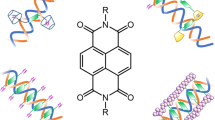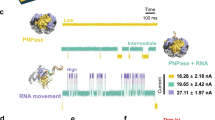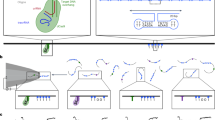Abstract
Detection of mutations and damaged DNA bases is important for the early diagnosis of genetic disease. Here we describe an electrocatalytic method for the detection of single-base mismatches as well as DNA base lesions in fully hybridized duplexes, based on charge transport through DNA films. Gold electrodes modified with preassembled DNA duplexes are used to monitor the electrocatalytic signal of methylene blue, a redox-active DNA intercalator, coupled to [Fe(CN)6]3−. The presence of mismatched or damaged DNA bases substantially diminishes the electrocatalytic signal. Because this assay is not a measure of differential hybridization, all single-base mismatches, including thermodynamically stable GT and GA mismatches, can be detected without stringent hybridization conditions. Furthermore, many common DNA lesions and “hot spot” mutations in the human p53 genome can be distinguished from perfect duplexes. Finally, we have demonstrated the application of this technology in a chip-based format. This system provides a sensitive method for probing the integrity of DNA sequences and a completely new approach to single-base mismatch detection.
This is a preview of subscription content, access via your institution
Access options
Subscribe to this journal
Receive 12 print issues and online access
$209.00 per year
only $17.42 per issue
Buy this article
- Purchase on Springer Link
- Instant access to full article PDF
Prices may be subject to local taxes which are calculated during checkout






Similar content being viewed by others
References
Schafer, A.J. & Hawkins, J.R. DNA variation and the future of human genetics. Nat. Biotechnol. 16, 33–39 (1998).
Marshall, A. & Hodgson, J. DNA chips: an array of possibilities. Nat. Biotechnol. 16, 27–31 (1998).
Hacia, J.G. Resequencing and mutational analysis using oligonucleotide microarrays. Nat. Genet. 21, 42–47 (1999).
Ramsay, G. DNA chips: State-of-the-art. Nat. Biotechnol. 16, 40–44 (1998).
Kelley, S.O., Holmlin, R.E., Stemp, E.D.A. & Barton, J.K. Photoinduced electron transfer in ethidium-modified DNA duplexes—dependence on distance and base stacking. J. Am. Chem. Soc. 119, 9861–9870 (1997).
Kelley, S.O. & Barton, J.K. Electron transfer between bases in double helical DNA. Science 283, 375–381 (1999).
Holmlin, R.E., Dandliker, P.J. & Barton, J.K. Charge transfer through the DNA base stack. Angew. Chem. Int. Edn. Engl. 36, 2714–2730 (1997).
Gasper S.M. et al. Three-dimensional structure and reactivity of a photochemical cleavage agent bound to DNA. J. Am. Chem. Soc. 120, 12402–12409 (1998).
Kelley, S.O., Jackson, N.M., Hill, M.G. & Barton, J.K. Long-range electron transfer through DNA films. Angew. Chem. Int. Edn. Engl. 38, 941–945 (1998).
Kelley, S.O., Boon, E.M., Jackson, N.M., Hill, M.G. & Barton, J.K. Single-base mismatch detection based on charge transduction through DNA. Nucleic Acids Res. 27, 4830–4837 (1999).
Kelley, S.O., Jackson, N.M., Barton, J.K. & Hill, M.G. Electrochemistry of methylene blue bound to a DNA-modified electrode. Bioconjug. Chem. 8, 31–37 (1997).
Kelley, S.O. et al. Orienting DNA helices on gold using applied electric fields. Langmuir 14, 6781–6784 (1998).
Ropp, P.A. & Thorp, H.H. Site-selective electron transfer from purines to electrocatalysts: voltammetric detection of a biologically relevant deletion in hybridized DNA duplexes. Chem. Biol. 6, 599–605 (1999).
Kramer, B., Kramer, W. & Fritz, H.J. Different base base mismatches are corrected with different efficiencies by the methyl-directed DNA mismatch-repair system of Escherichia Coli. Cell 38, 879–887 (1984).
Hunter, W.N., Leonard, G.A. & Brown, T. Hydrogen-bonding patterns observed in the base pairs of duplex oligonucleotides. ACS Sym. Ser. 682, 77–90 (1998).
Luxon, B.A. & Gorenstein, D.G. Comparison of X-ray and NMR-determined nucleic acid structures. Methods Enzymol. 261, 45–73 (1995).
Forman, J.E. et al. Thermodynamics of duplex formation and mismatch discrimination on photolithographically synthesized oligonucleotide arrays. ACS Sym. Ser. 682, 206–228 (1998).
Peyret N. et al. Nearest-neighbor thermodynamics and NMR of DNA sequences with internal AA, CC, GG, and TT mismatches. Biochemistry 38, 3468–3477(1999).
SantaLucia, J. A unified view of polymer, dumbbell, and oligonucleotide DNA nearest-neighbor thermodynamics. Proc. Natl. Acad. Sci. USA 95, 1460–1465 (1998).
Hainaut, P. et al. IARC Database of p53 gene mutations in human tumors and cell lines: updated compilation, revised formats and new visualization tools. Nucleic Acids Res. 26, 205–213 (1998).
Cho, Y.J., Gorina, S., Jeffrey, P.D. & Pavletich, N.P. Crystal structure of a p53 tumor-suppressor DNA complex—understanding tumorigenic mutations. Science 265, 346–355 (1994).
Ryberg, D. et al. p53 mutations in lung tumors—relationship to putative susceptibility markers for cancer. Cancer Res. 54, 1551–1555 (1994).
Kirby, G.M. et al. Allele-specific PCR analysis of p53 codon 249 AGT transversion in liver tissues from patients with viral hepatitis. Int. J. Cancer 68, 21–25 (1996).
Friedberg, E.C., Walker, G.C. & Siede, W. DNA repair and mutagenesis. (ASM Press, Washington, DC; 1995).
Izzotti, A. Detection of modified DNA nucleotides by postlabeling procedures. Toxicol. Methods 8, 175–205 (1998).
Harrison, J.G. & Balasubramanian, S.A. Convenient synthetic route to oligonucleotide conjugates. Bioorg. Med. Chem. Lett. 7, 1041–1046 (1997).
Acknowledgements
We are grateful to the NIH for financial support (GM61077). We also thank M.J. Fitzsimmons and J.L. Lamb in Device Research at JPL for assistance in the fabrication of the DNA chips.
Author information
Authors and Affiliations
Corresponding authors
Rights and permissions
About this article
Cite this article
Boon, E., Ceres, D., Drummond, T. et al. Mutation detection by electrocatalysis at DNA-modified electrodes. Nat Biotechnol 18, 1096–1100 (2000). https://doi.org/10.1038/80301
Received:
Accepted:
Issue Date:
DOI: https://doi.org/10.1038/80301
This article is cited by
-
Label-Free Electrochemical Detection of DNA Hybridization: A Method for COVID-19 Diagnosis
Transactions of the Indian National Academy of Engineering (2020)
-
Rich-color visual genotyping of single-nucleotide polymorphisms based on platinum nanoparticle–induced etching of gold nanorods
Emergent Materials (2019)
-
Innovations in biomedical nanoengineering: nanowell array biosensor
Nano Convergence (2018)
-
Switchable DNA wire: deposition-stripping of copper nanoclusters as an “ON-OFF” nanoswitch
Scientific Reports (2016)



